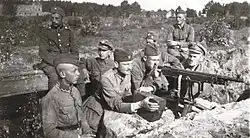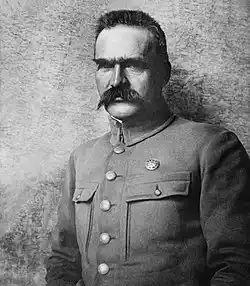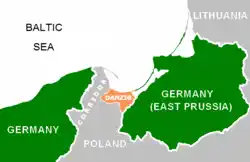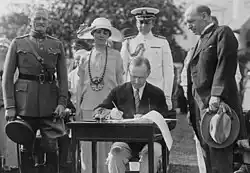
Interwar Poland refers to the period of Polish history running from the end of the First World War in 1918 and the commencement of the Second World War in 1939. This was a period of rapid change and turbulence in the political and social history of Poland. A fully independent Polish state had not existed for over a century since the Partitions of Poland in the late eighteenth century brought the Polish-Lithuanian Commonwealth to an end. The Poles had to fight for their independence in the Polish-Russian War (1919–1921), a component conflict of the wider Russian Civil War. A coup d'état followed in 1926, one which saw Poland flirt with various authoritarian governments for the rest of the interwar period. Tensions also ran high with neighboring Germany after the rise to power of the Nazis in 1933. There was migration to and from Poland in this period, with a growing strain of anti-Semitism in the country leading several governments to encourage Jewish people to migrate to the Levant from a country which had the largest Ashkenazi Jewish community in Europe during the interwar period. Minorities such as the Ukrainians also experienced discrimination in interwar Poland.[1]
Research your ancestors on MyHeritage
Interwar Poland chronology of eventsInterwar Poland chronology of events

The Kingdom of Poland had been one of the great powers of Eastern Europe throughout the High Middle Ages and the late medieval era. In early modern times it became greater still after uniting with the Grand Duchy of Lithuania to form the Polish-Lithuanian Commonwealth in the mid-sixteenth century. This was a vast state, one which ruled over a region approximating with modern-day Poland, Lithuania, Latvia, much of Belarus, western and central Ukraine and parts of Russia. However, after a golden age in the late sixteenth and seventeenth century, the Commonwealth declined rapidly in the eighteenth century and was carved up and annexed by Russia, Prussia and Austria through the Partitions of Poland between 1772 and 1795. Although a Duchy of Warsaw was briefly created as a French satellite state in Eastern Europe during the Napoleonic Wars, it was short-lived and there was effectively no independent Polish state down to the outbreak of the First World War in 1914.[2]
The First World War ended with the collapse of all three of the states that had carved up the Polish-Lithuanian Commonwealth between them in the late eighteenth century. The German Empire (formed under Prussian leadership in 1871) and the Austro-Hungarian Empire both lost the war, while the Russian Empire had already fragmented into revolution and civil war in 1917. Out of the chaos a new, independent Polish republic emerged. It had to fight a war of independence against the Russian communists between 1919 and 1921, but with the backing of Britain and France it managed to carve out a large territorial state, one which included large sections of what are now Ukraine, Belarus and Lithuania.[3]

The new interwar state is known as the Second Polish Republic. It is often viewed through a rosy lens as a model democracy on account of it becoming a victim of the aggression of its neighbors in 1939, but it did have problems of its own long before this. The politics of the new nation were chaotic through the first half of the 1920s, marred by the hyperinflation which also impacted countries like neighboring Germany at this time. Then, in 1926, a quasi-military dictatorship emerged after a coup led by Major Józef Piłsudski. Thereafter Poland went through a period of varying degrees of political stability. As a primarily agricultural country, Poland was badly hit by the Great Depression, while the rise of the Nazi regime in Germany in 1933 led to increasing tensions over the Danzig corridor, the strip of land which provided Poland with access to the Baltic Sea but which split the bulk of Germany from its lands in Prussia. Eventually the Second Polish Republic came to an end when the Nazis invaded the country on the 1st of September 1939, occupying the country after a swift six-week long campaign. This also led to the outbreak of the Second World War.[4]
Extent of migration associated with Interwar PolandExtent of migration associated with Interwar Poland
The region around Poland, though under German, Russian and Austro-Hungarian rule at the time, had experienced mass migration in the late nineteenth and early twentieth centuries. Poles were one of the largest ethnic groups involved in trans-Atlantic migration to the United States in the 1880s, 1890s, 1900s and 1910s. This continued to some limited extent in the interwar period, but the Immigration Act of 1924 considerably restricted inward migration into the United States, curbing Polish migration in the process.[5]

Consequently, most of the migration which occurred from Interwar Poland involved people going to and from other regions. Some of it was people simply moving across the borders which had been redrawn all over Europe in the aftermath of the First World War. For instance, some ethnic Poles who found themselves living in Weimar Germany or the USSR once the fighting ended, migrated to the new Polish state, while some Germans who now ended up under Polish rule went to live in the reduced German state. Similarly, owing to discriminatory policies, many Ukrainians left the Second Polish Republic and headed eastwards into the Ukrainian Soviet Socialist Republic, though the degree to which this occurred was severely limited by the outbreak of a terrible famine, the Holodomor, in Ukraine in south-western Russia in the early 1930s.[6]
A major factor in migration from Interwar Poland was the position of the Jewish community in the Second Polish Republic. Poland had become home to the largest Jewish community in Europe in late medieval and early modern times, as the environment here was much more tolerant of Jewish people than was the case in places like England and France, where pogroms and mass expulsions of the Jewish people took place in the thirteenth and fourteenth centuries. As a consequence, Poland was home to the largest Jewish community in Europe in the Interwar era. There was a creeping anti-Semitism in Poland, particularly so from the late 1920s onwards. This led successive Polish governments to encourage migration from Poland to the burgeoning Jewish state in the British Mandate lands in the Levant.[7]
Demographic impact of migration in Interwar PolandDemographic impact of migration in Interwar Poland
The demographic impact of this migration was modest and might have been greater still had it not been for curbs on migration such as the US Immigration Act of 1924. It was perhaps most keenly felt in the Levant, where the Jewish population of the British Mandated territory increased from around 85,000 in 1922 to 175,000 in 1931 and then to around 450,000 by the time of the outbreak of the Second World War in 1945. Many of those involved in this migration were Jewish people from Poland.[8] This aside, the demographic impact of migration in Interwar Poland was eclipsed by the demographic changes wrought by the Second World War in Poland, when the Holocaust devastated the country’s Jewish population and a fundamental redrawing of Poland’s borders led yet again to major shifts in the size of the population of minorities such as the Germans, Ukrainians and Belarusians.[9]
See alsoSee also
Explore more about Interwar PolandExplore more about Interwar Poland
- Poland, Gravestones, 1800-2020 records collection on MyHeritage
- Poland, Military Personnel records collection on MyHeritage
- Poland, Masovian, Warsaw Burials records collection on MyHeritage
- Poland, Lublin Roman Catholic Church Books, 1784-1964 records collection on MyHeritage
- Mandatory Palestine Naturalization Applications, 1937-1947 records collection on MyHeritage
- Ellis Island and Other New York Passenger Lists, 1820-1957 records collection on MyHeritage
- Beginning Polish Genealogy at Legacy Family Tree Webinars
- Polish genealogy online - portals and databases at Legacy Family Tree Webinars
- Polish Communities - Migration and Resettlement at Legacy Family Tree Webinars
- Using MyHeritage to research Polish family history and to find living relatives in Poland at Legacy Family Tree Webinars
References
- ↑ http://www.historyisnowmagazine.com/blog/2022/1/11/poland-in-the-interwar-years-1918-1939
- ↑ https://www.bbc.com/news/world-europe-17754512
- ↑ John A. Drobnicki, ‘The Russo-Polish War, 1919–1920’, in The Polish Review, Vol. 42, No. 1 (1997), pp. 95–104.
- ↑ Piotr S. Wandycz, ‘The Second Republic, 1921–1939’, in The Polish Review, Vol. 54, No. 2 (2009), pp. 159–171.
- ↑ https://www.migrationpolicy.org/article/1924-us-immigration-act-history
- ↑ https://cla.umn.edu/chgs/holocaust-genocide-education/resource-guides/holodomor
- ↑ https://ukrainianjewishencounter.org/media/Ukraina-Moderna-article-on-Jewish-emigration_Eng_Web.pdf
- ↑ https://www.jewishvirtuallibrary.org/jewish-and-non-jewish-population-of-israel-palestine-1517-present
- ↑ Joyce Marshall, ‘The German-Polish Boundary’, in Columbia Journal of International Affairs, Vol. 4, No. 2 (Spring, 1950), pp. 77–79.

